Recently, those of us that are big fans of unusual fish have been a little spoiled by Japanese sets. As is common, they are featuring some unique species that are visually or culturally striking. In this case, Takara Tomy brought us a set of fish that are notable for being scary looking, notorious, and somehow engaging for fishing (I think). The set appears to translate as World Fishing Monster Fish, although some translations appear to have the word ‘battle’ or ‘war’ in there but I can’t be certain. In any case, the set of four contains fish that are certainly unique-looking, and in many instances have been made notable through appearances on shows like River Monsters and, yes, Monster Fish, for their ferocity and difficulty in catching (side note, we need shows like these again). Perhaps no fish exemplifies the idea of a fish that is difficult to get to, difficult to catch, and difficult to avoid injury with, then the Goliath Tigerfish Hydrocynus goliath.
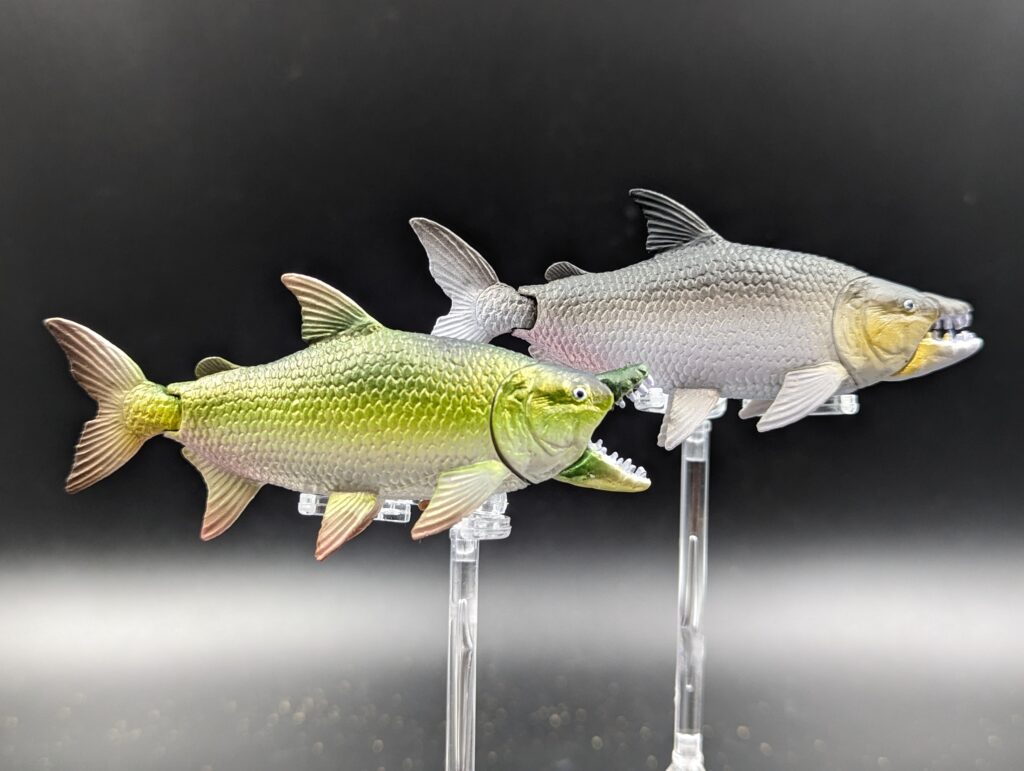
A tigerfish has shown up on the blog once before, as part of a Toy Fish Factory set (also called River Monsters!). Otherwise, these fish don’t see much attention. That linked blog post was also handy in that it introduced most of what we need to say about goliath tigerfish, so I will only expand on it a little.
I want to say right out that I would never disparage the Toy Fish Factory model, but these Takara figures have put a lot of thought into giving us as good a representation of these powerful characins as would be possible short of very fancy resin or commissioned models. Let’s take a closer look!
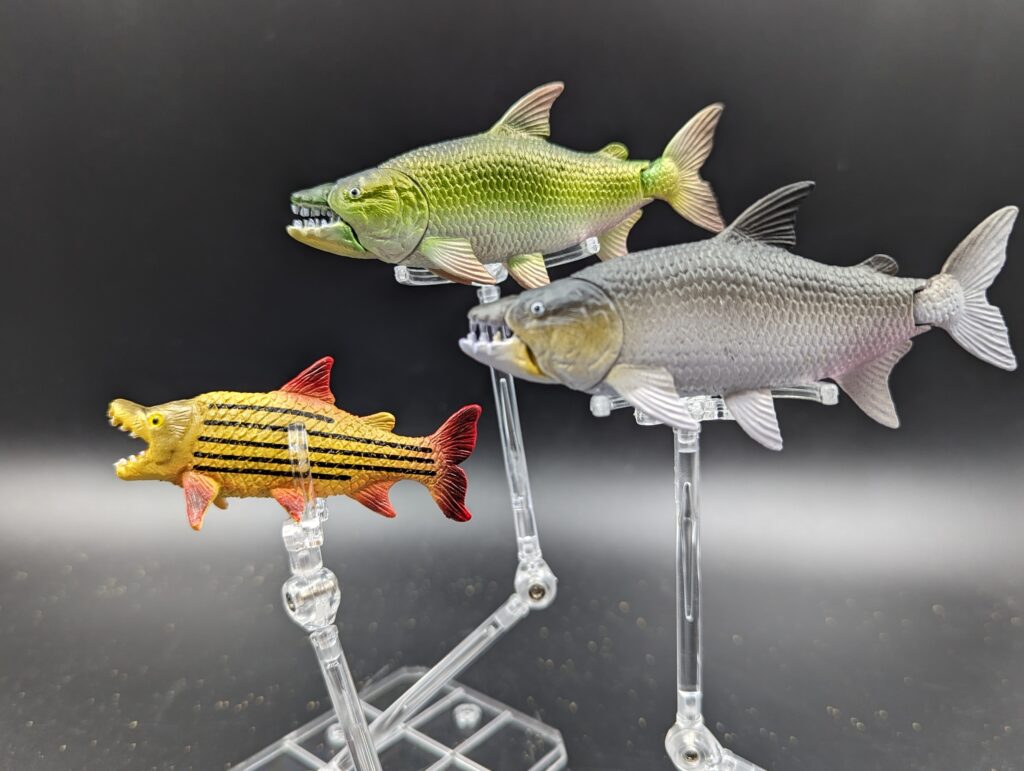
As mentioned (and might be obvious from these figures), goliath tigerfish are very predatory, aggressive hunters, with large teeth meant to catch and hold their fish prey. They became a little more infamous from an episode of River Monsters (with Jeremy Wade) where they described potential attacks on human that had shiny metals on them in the water. As many fisherfolk know, a lot of lures for fish include the use of metallic reflection to imitate rapidly swimming fish to instigate an attack response; the problem comes in when the fish in question can be 1.5 metres (~5′) long, with dagger-like teeth up to 2.5cm (1″) long. It’s also impressive that in their native waters, the only normal predator of them as adults is crocodiles.
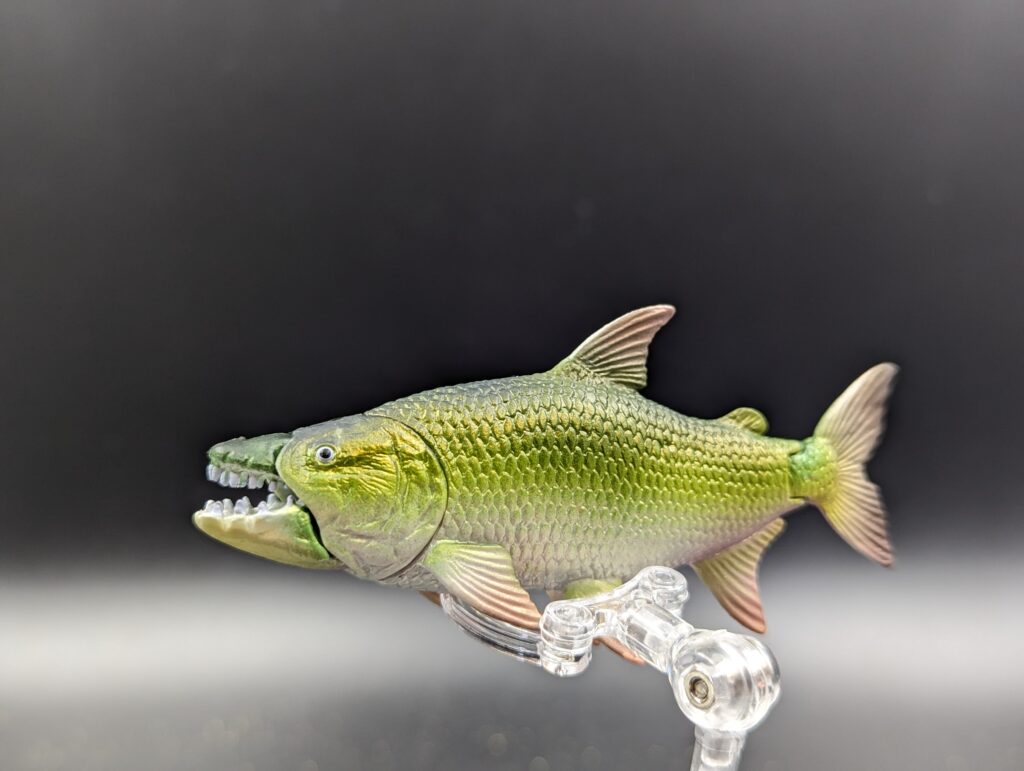
For a fish that has such a reputation, they have become considered a premier sport fish for those that can go out to fish for them. According to the IUCN their status is still Least Concern which, for a large freshwater animal, is pretty great and sadly unusual. Interestingly, goliath tigerfish are referred to a range through the Congo basin and Lake Tanganyika, some mtDNA work indicates that the goliath tigerfish should be restricted to the Congo basin only, with several other species inhabiting Lake Tanganyika.
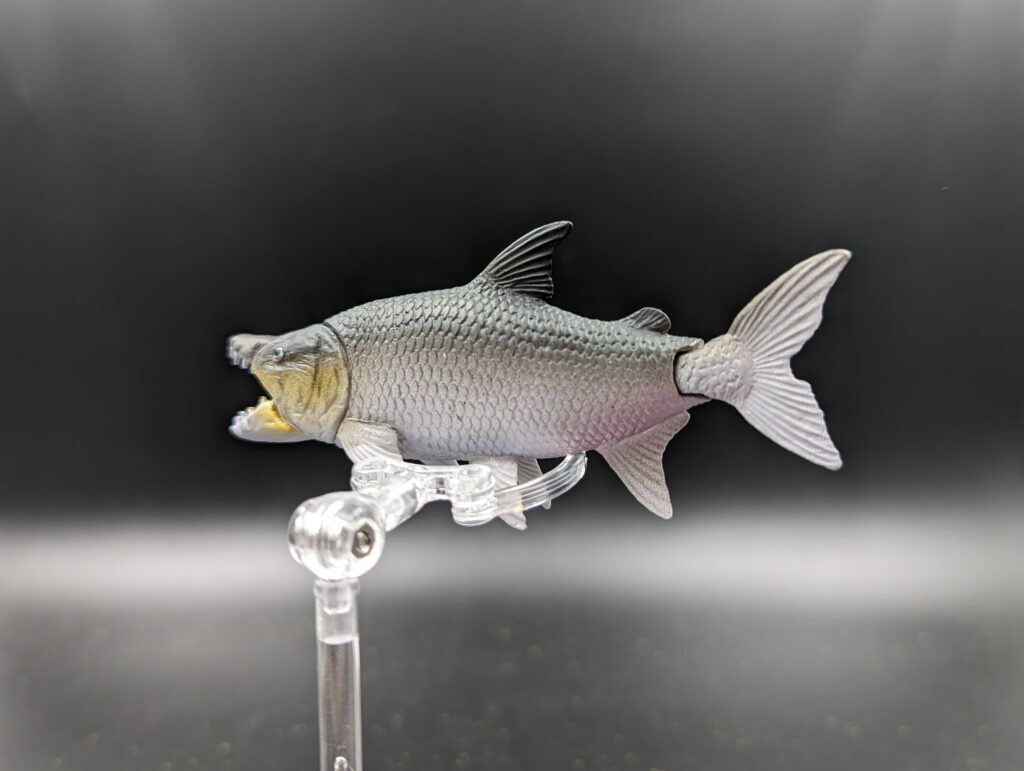
To describe the model design, they are quite impressive. As is the case with many of the recent Takara Tomy sets now, they provide some articulations in the fish to give some movement, which means they require minor assembly. They arrive in three pieces–the body, the tail, and the head (with mouth already assembled). These parts are interchangeable if you want, although they look odd (see photo). The tail joint is especially noticeable, and for display probably works best in a neutral straight line. The head is separated at the opercula, so that seam is well hidden within normal fish physiology.
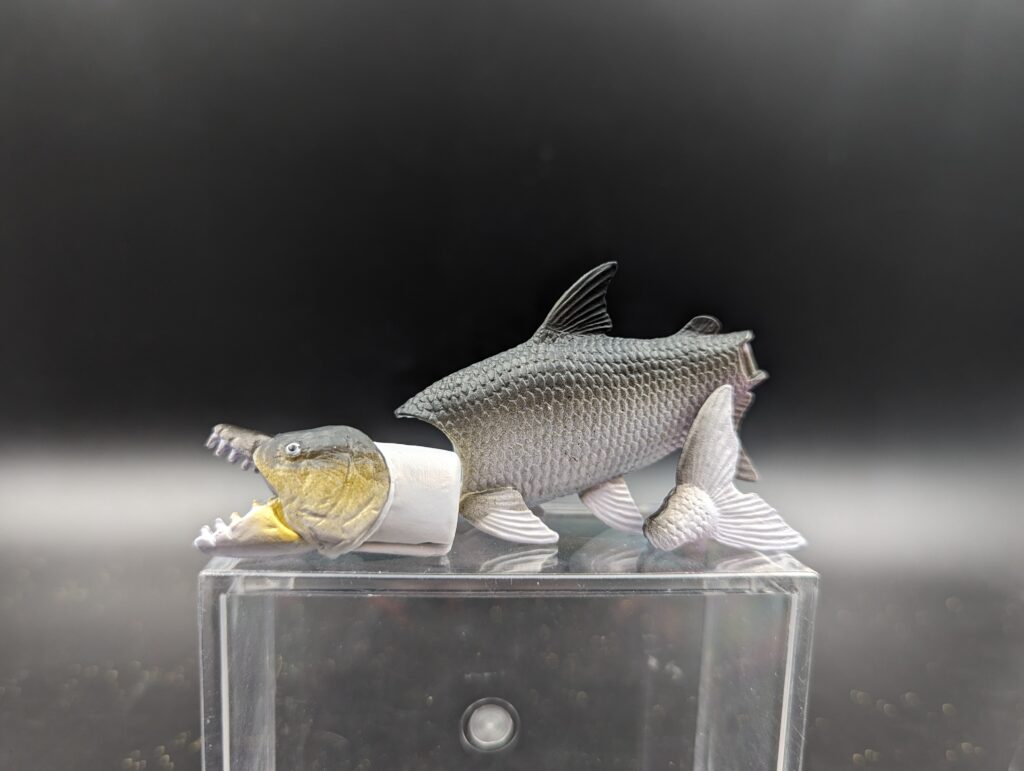
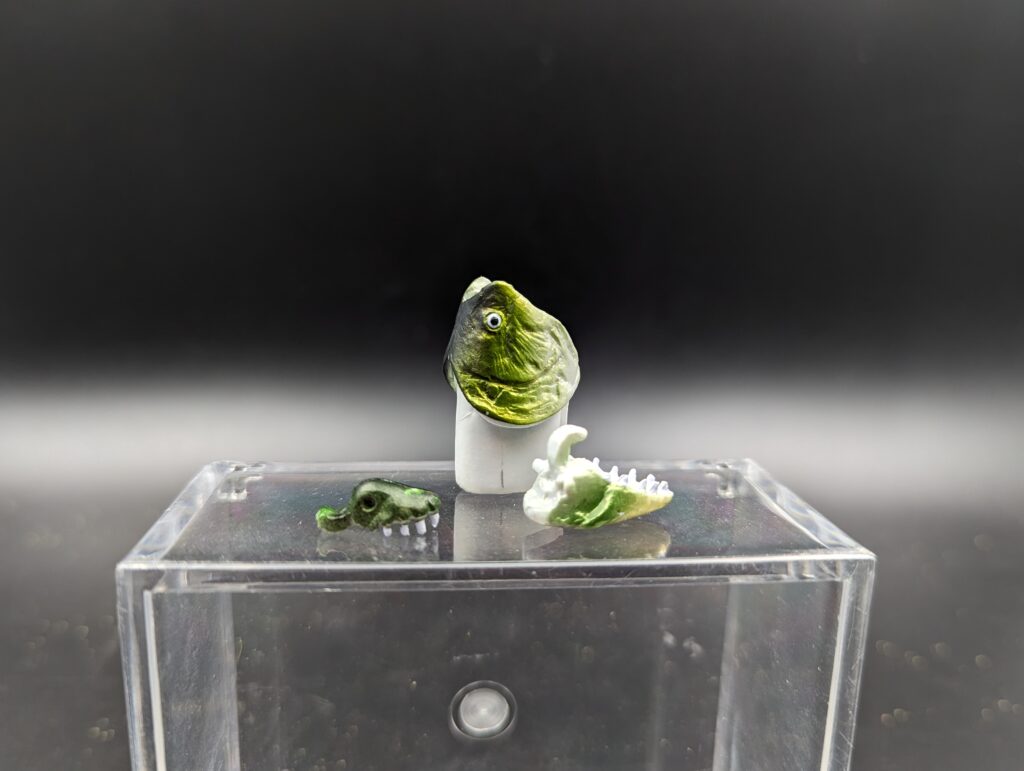
The best part of these figures, and a way they truly take advantage of the figure design, is the articulated mouth that properly represents the way a tigerfish actually bites. Instead of a simple dropping of the lower jaw as seen in simple figures from…everyone…these figures have a lever system that actually causes both the upper and lower jaw to lift and drop, respectively, in equal measure. This reflects an adaptation by tigerfish to maximize the pierce and slash with those big teeth. The hinging is fairly solid even though the material is somewhat soft, in between rubber and PVC. This is probably good as the figure will not wear or break with repeated movement, and the dual hinge is easy to put back in place if the pieces slip (they can, and as the photo shows, do). Despite this feature being so impressively designed, I know that the visible joints will give some collectors pause. I say these figures are still worth it.
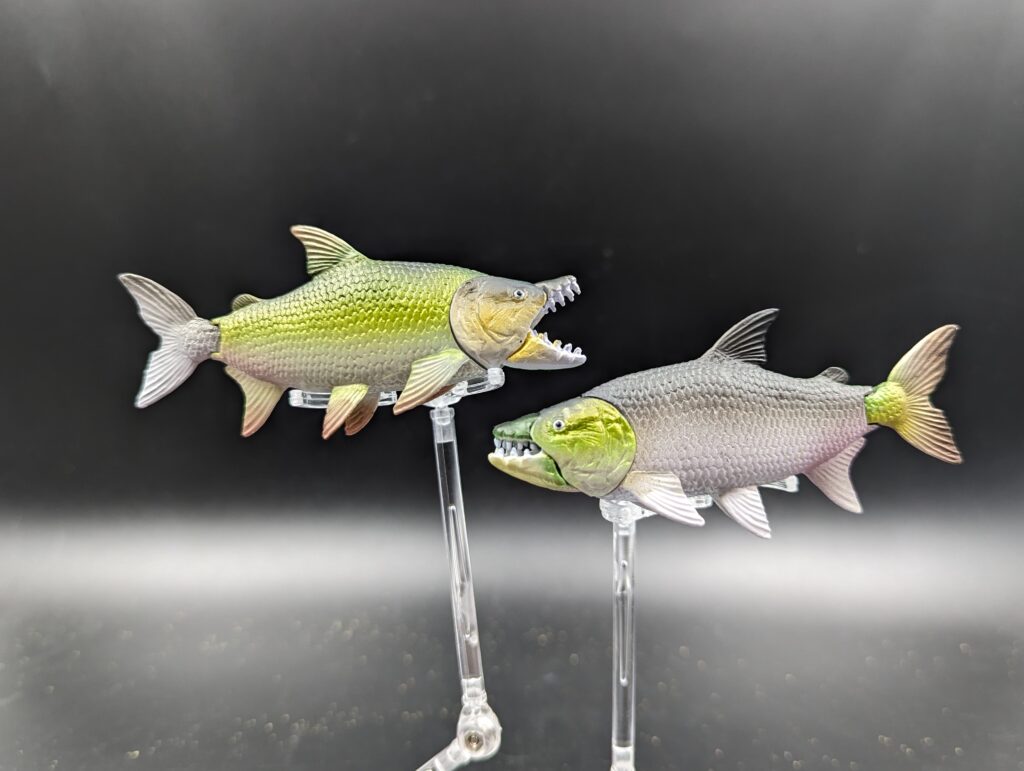
First off, the figures are about 10.4 cm long TL; this puts them at about 1:13 or so scale for a full size adult, so a pretty big scale as far as modern animals are concerned. But it does give some nice heft to the figures. The body is appropriately stocky and fusiform, with a steep but gradual rise along the back to the first dorsal fin, then a drop down to the peduncle; from what I can tell, this is a little exaggerated from most goliath tigerfish, but there are photos of some deep-bodied big boys, so it might be related to being at maximum size or something.

The finnage is appropriate, with the very high first dorsal fin placed midway and the very small second dorsal right at the base of the caudal peduncle. The pectoral and pelvic fins are well placed, and the anal fin is properly long at the anterior margin, with a sharp front point and long base extending to the peduncle; there could stand to be a deeper notch here. The caudal fin is symmetrical and deeply forked, with the correct notch in the mid-line of the posterior margin. The tail fin, as well as the first dorsal and anal fins, could be more sharply pointed and trail more at the tips, but this is probably limited by the material. I will comment on overall colour(s) in a moment, but the deep vivid hues and pattern of the tail are missed on both figures, and all of the fins on one are missing the reddish tinge that is often present. This is in direct contrast with the TFF figure, where all of the fins are almost excessively red. That said, there is no shortage of photos of goliath tigerfish with basic silver fins, so it isn’t incorrect, but it would look neat on at least one of the two.

The overall morphology of the most impressive feature–the head–is pretty good. The mouth is slightly prognathic, as it should be, with the lower jaw jutting forward just a little when closed. There are five very obvious, pointy teeth in each quadrant of the model, which appears to be correct. Given the scale of the fish, one might think the teeth are a bit exaggerated but at 1:13 scale, they should be 2mm long–and the longest teeth actually are! It seems like such a small thing, but to get the jaw position and tooth height correct and to-scale in a small figure like this is kind of impressive.
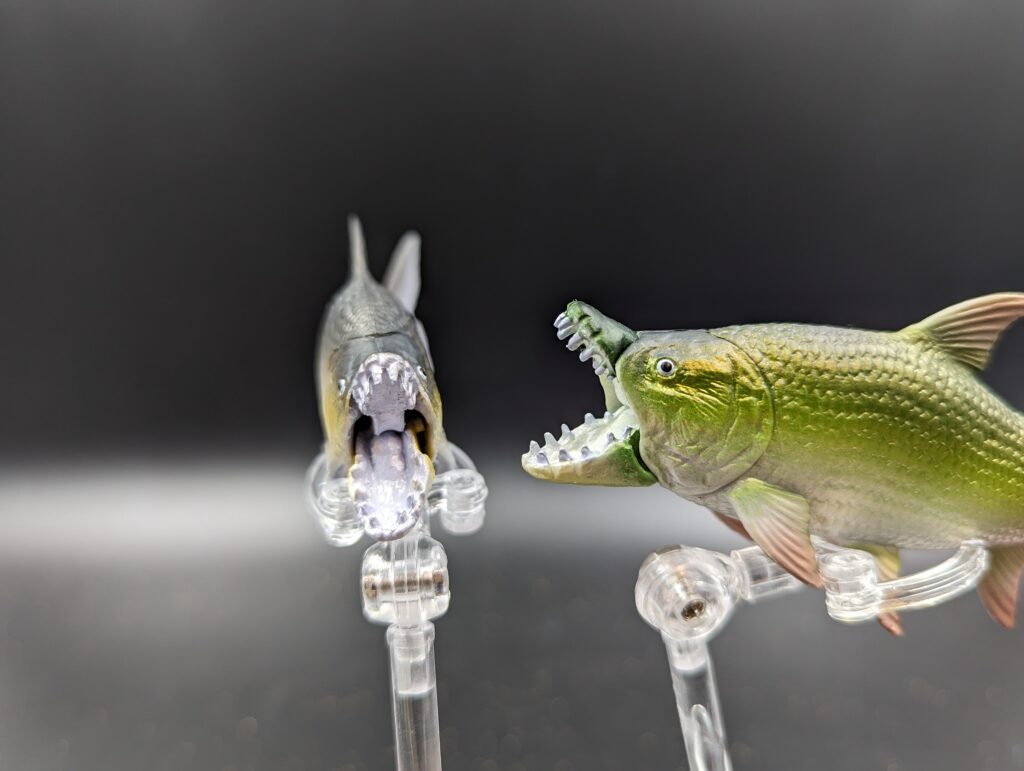
The head is sculpted with the expected ornamentation, possibly not as smooth as it should be. The eyes are appropriately large, with cream-coloured sclera and a large black pupil dead centre, giving a very alert expression (not that fish faces have many expressions…) The opercula are large and deep, and, again, shaped in a way to hide the fact that the head overall is a separate piece (again, all fish figures that are in pieces should do this, it’s such an obvious place to do it). The scales along the body are large and diamond-shaped, fairly uniform in size across the whole body, from dorsum to ventrum, and from behind the opercula to the caudal peduncle.

Now for the colours–as seems to be the case with many of these Takara TOMY articulated sets, one of the models is produced in two colours. In this case, it is the tigerfish. They are usually referred to as A and B; in this instance, as best as I could find, A is the more greenish model, and B is the more silvery model.

Starting with version A, this fish is green. Although I’m unfamiliar with this, it’s apparently not unheard of, although I’d guess it’s usually pretty subtle. This figure is not subtle. The primary colour of the model is a bright emerald to lime green, covering most of the lower jaw, the head, and the top two thirds of the body all the way to the entirety of the caudal peduncle. On the dorsal surface is a dark wash, darkest in front of the first dorsal and top of head. At about two thirds down the sides of the body, there is a quick transition to a white belly. Over the anal fin is a slight pinkish hue, but otherwise the ventral colour is uniform. The bottom of the lower jaw is more of a golden-green, and when the mouth is closed a pinkish highlight can be seen at the joint. There is no trace of dots, stripes or other markings along the side–it could be, like everything else, this is intraspecifically variable.

All of the fins of this figure (other than the second dorsal) have at least a pinkish hue on the distal edges, which is about as close as we’ll get to the bright red or vermillion seen even in some photos. There are no other marks or stripes. The first dorsal fin has a base colour of green with an abrupt transition to pink; the second dorsal is all green. The paired fins are green only at their joints, transitioning to white and then pink by the distal edges. The anal fin is the same, except no white. The tail fin fades from very light pink at the peduncle to a darker pink at the posterior margin, with a black wash on the very edge; this is reminiscent of the fish in life, although is usually more abrupt and also found on the other large fins.
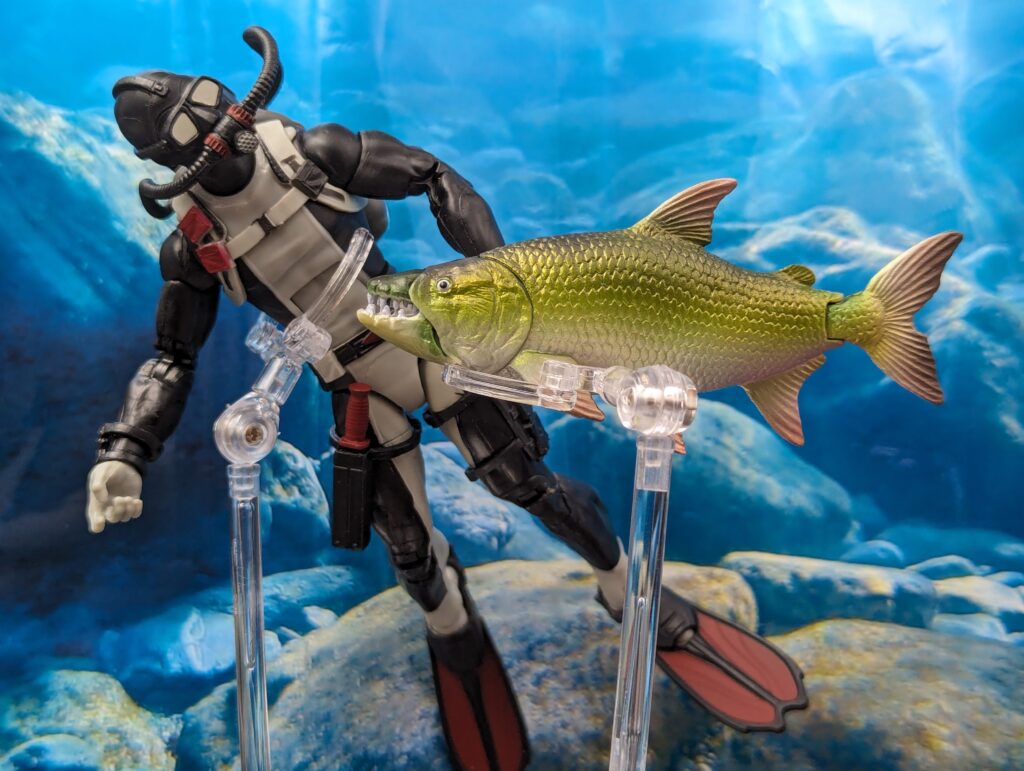
Of important note is the finish on the Version A fish. It is very shiny and metallic, which is part of the reason I would call the green either lime (if not shining) or emerald (if it is). It is a very flashy figure, and the glossy finish is found on all surfaces throughout the figure. This is in direct contrast to figure B, the grey model, which could be described as possibly semi-gloss at most, certainly nowhere near as metallic. I’m wondering if the green metallic sheen is meant to invoke an animal swimming in somewhat shaded water, versus a fish out of water, or in clearer water?
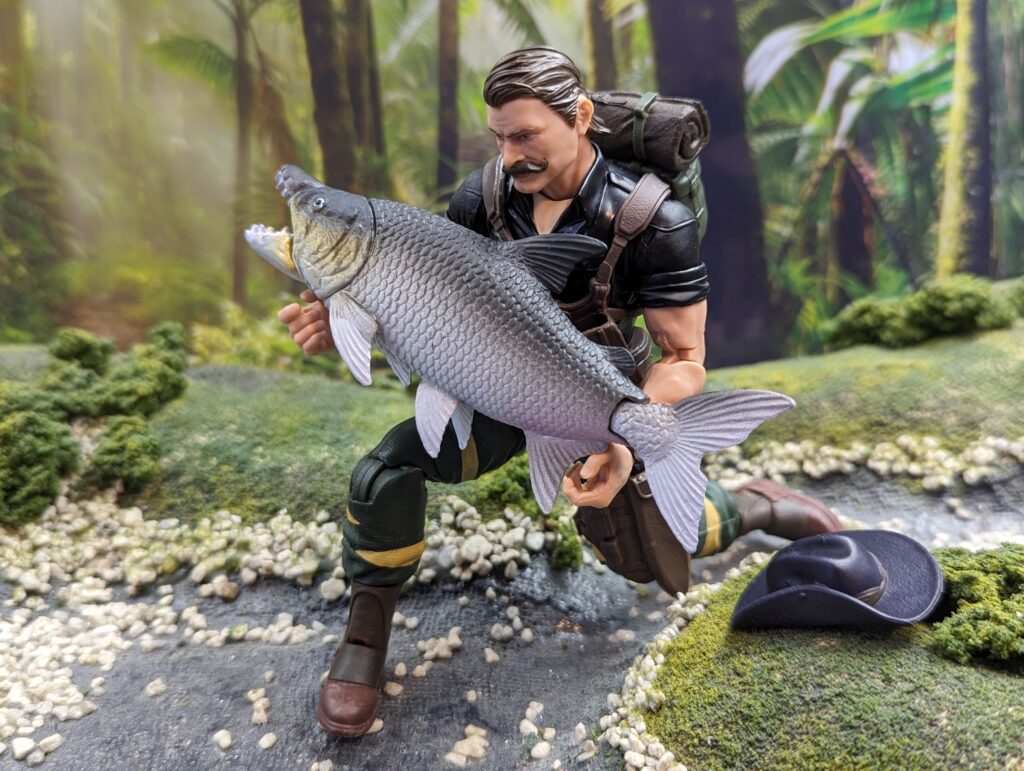
(Segue!) The colour of figure B is probably closer to the more familiar colours of the goliath tigerfish. Again, no stripes, spots or dots, but overall a more silvery fish. The dorsal surface of the fish, including the dorsal fins and upper margin of the tail, is a very dark grey with brownish tones. This colour fades very gradually to about the midline, where it transitions into white. The edge of the jaw and the lower opercula are painted with a shiny copper; the base of the anal fin has a shiny pink highlight that does not reach into the fin (this copper and pink appears to the be the shiniest element of the fish). The lower fins are mostly white with some grey highlighting (the left pectoral has a grey upper, possibly a paint flaw). The caudal peduncle and tail fin are also white, same the aforementioned dark margin.

In general, I can’t recommend these figures enough. Working within the style of the Takara series, these are about as great as we can hope for larger capsule models. Of course, I have the whole set (of 4) and will discuss the other two in time but this post went long enough for one model/two figures. I was happy to get both, although some collectors may pick and choose; as with any of these Takara sets they do seem to have limited runs, so I would recommend acting sooner rather than later. But I’ll say it again, for those who enjoy freshwater animals or fish overall–or just unique animals in general–these are probably not to be missed. I don’t expect we’ll see other tigerfish figures anytime soon–the only other one ever released was the Toy Fish Factory one…and some of us remember the Kaiyodo anniversary figure that was teased by never released…so add something swimmy and scary looking to your collection while you can!
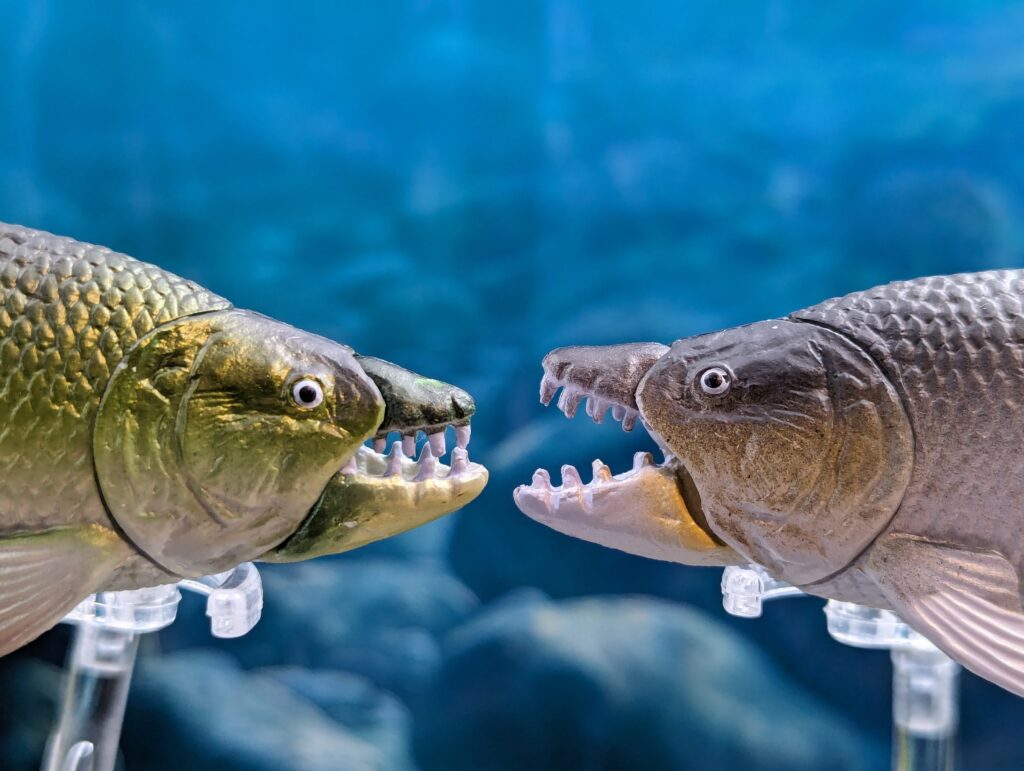
Disclaimer: links to Ebay and Amazon on the AnimalToyBlog are affiliate links, so we make a small commission if you use them. Thanks for supporting us!




You’ve convinced me to replace the TFF version of this species with one of these. I was able to order the green one online!
They’re so good! Still toys, but on another level from the TFF